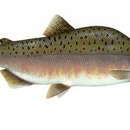The pink salmon,
Oncorhynchus gorbuscha, also often called humpback salmon or humpy, is the smallest and most common of the “true” salmon native to the North Pacific (genus
Oncorhynchus). Like all the pacific salmon, it is anadromous, returning to freshwater streams to spawn (not always its natal stream, however) after spending 18 months feeding and maturing at sea. Males develop a hump as a secondary sexual characteristic upon returning to streams to spawn, hence its common name. Adults die after spawning. Pink salmon have a two-year life-cycle. Because of this, some rivers produce salmon on even years, some on an “odd” schedule; these populations do not interbreed. Genetic studies indicate that even and odd spawning strains in some rivers have become genetically isolated lines (Heard 1991). Though some strains are imperiled or have been extirpated in California and Washington, NOAA indicates that Pacific Northwest humpback populations are generally healthy, and Alaskan populations are abundant and sustainably harvested under the Pacific Salmon Treaty. Pink salmon is most commonly sold canned. In addition to its native distribution across the North Pacific and Bering Sea from southern California to North East Asia, the pink salmon is also found in the Great Lakes, where the species was accidentally introduced in 1956. (Heard 1991;
NOAA/National Marine Fisheries Service Fishwatch;
Pacific Salmon Commission;
Wikipedia 2012)

